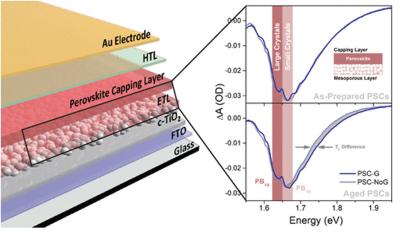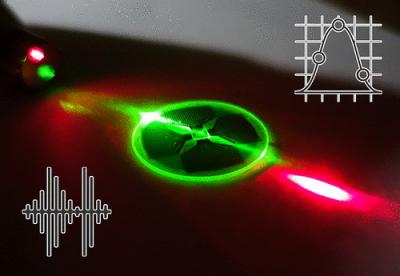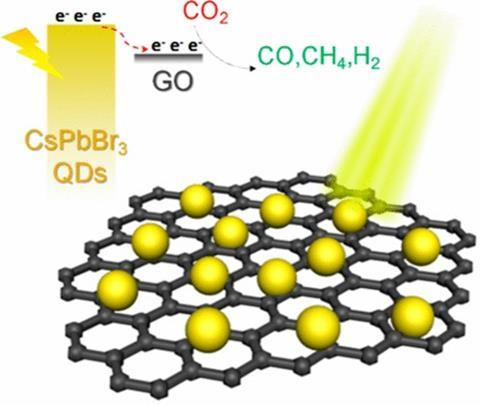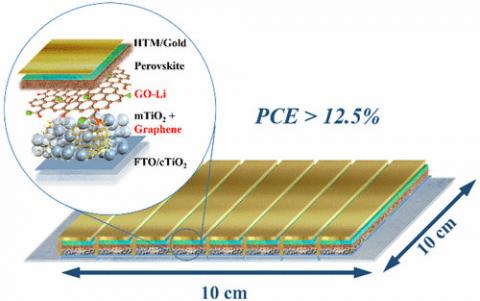Perovskites are materials that share a crystal structure similar to the mineral called perovskite, which consists of calcium titanium oxide (CaTiO3).
Depending on which atoms/molecules are used in the structure, perovskites can possess an impressive array of interesting properties including superconductivity, ferroelectricity, charge ordering, spin dependent transport and much more. Perovskites therefore hold exciting opportunities for physicists, chemists and material scientists.
Graphene is a one-atom-thick layer of carbon atoms arranged in a hexagonal lattice. It is the building-block of Graphite (which is used, among others things, in pencil tips), but graphene is a remarkable substance on its own - with a multitude of astonishing properties which repeatedly earn it the title “wonder material”. Graphene is the thinnest material known to man at one atom thick, and also incredibly strong - about 200 times stronger than steel. On top of that, graphene is an excellent conductor of heat and electricity and has interesting light absorption abilities. These varied properties make it a promising and highly researched material, with hopes of incorporating it in many applications: from inks and composite materials, through sensors, solar cells and water filters, to batteries and supercapacitors.
Due to their unique properties, carbon-based nanomaterials have been the center of extensive research efforts in various fields, one of which is the field of photovoltaic energy conversion. In recent years, hybrid metalorganic halide perovskites have become one of the most promising materials for third generation solar cells, with efficiencies that are constantly on the rise.
The incorporation of graphene into perovskite-based solar cells was naturally proposed, and significant work is taking place on this matter. Graphene-based perovskite solar cells are studied in many ways, including hole and electron transport media (HTM and ETM), electrodes, and various approaches aiming at improving the stability of the device. Tandem architectures based on graphene interlayers are also of great interest.
In addition to solar cells, other areas of graphene and perovskite integration include sensors and photodetectors, QDs, nanocatalysts and more.
The latest Perovskite Graphene news:
Researchers use perovskite QDs to design a device that mimics brain cells used for human vision
University of Central Florida researchers are helping to close the gap separating human and machine minds, using a technology based on perovskite quantum dots. In a recent study, a UCF research team showed that by combining two promising nanomaterials into a new superstructure, they could create a nanoscale device that mimics the neural pathways of brain cells used for human vision.
"This is a baby step toward developing neuromorphic computers, which are computer processors that can simultaneously process and memorize information," said Jayan Thomas, an associate professor in UCF's NanoScience Technology Center and Department of Materials Science and Engineering. "This can reduce the processing time as well as the energy required for processing. At some time in the future, this invention may help to make robots that can think like humans."
Korean scientists develop graphene electrode to enable next-gen perovskite solar cells
Several research institutions in South Korea are actively conducting research and development on next-generation solar cells, heightening expectations for commercialization. The research team led by Prof. Yoon Soon-gil of Chungnam National University has developed a new graphene electrode to produce perovskite solar cells at a low temperature. In addition, the team led by Prof. Choi Kyoung-jin of the School of Materials Science and Engineering at UNIST has developed a new concept tandem solar cell using transparent conductive adhesives (TCA).
The graphene electrode developed by Professor Yoon's team can help create a perovskite solar cell at a low temperature and can raise both safety and economic efficiency.
Researchers improved the stability of PSCs using hybrids of graphene and molybdenum disulphide quantum dots
Researchers from the Graphene Flagship have managed to increase the stability of perovskite solar cells (PSCs) using hybrids of graphene and molybdenum disulphide quantum dots.

The team used molybdenum disulphide quantum dot/graphene hybrids to address PSCs' instability issue. The collaboration between research institutions and industrial partners enabled by Graphene Flagship, yielded an ink based on graphene and related materials (GRMs). Layering this over the PSCs caused them to drastically increase in stability.
Emberion team design perovskite-QDs that combine with graphene to create unique photodetectors
Emberion researchers have shown that colloidal quantum dots (QDs) combined with a graphene charge transducer can provide a photoconducting platform with high quantum efficiency and large intrinsic gain, yet compatible with cost-efficient polymer substrates. The team demonstrated methods to couple large QDs (>6 nm in diameter) with organometal halide perovskites, enabling hybrid graphene photo-transistor arrays on plastic foils.

The resulting arrays simultaneously exhibited a specific detectivity of 5 Ã 1012 Jones and high video-frame-rate performance. PbI2 and CH3NH3I co-mediated ligand exchange in PbS QDs improved surface passivation and facilitated electronic transport, yielding faster charge recovery, whereas PbS QDs embedded into a CH3NH3PbI3 matrix produce spatially separated photocarriers leading to large gain.
Graphene to increase efficiency of perovskite solar cells
Researchers from Italy's University of Florence have found that graphene could significantly improve the efficiency of perovskite solar cells. The researchers have shown how the introduction of graphene and graphene oxide doped with lithium atoms (GO-Li) into a perovskite-based cell may increase its conversion efficiency, as both the carrier recombination dynamics and the defect density of the perovskite are considerably improved.
The scientists used graphene doped mesoporous TiO2 (G+mTiO2) with the addition of a lithium-neutralized graphene oxide (GO-Li) interlayer as ETL. They found that the carrier collection efficiency is increased by about a factor two with respect to standard mTiO2.
Perovskite QDs combine with graphene oxide to create artificial photosynthesis
Researchers from Sun Yat-Sen University in China have created a composite of perovskite quantum dots and graphene oxide that can reduce CO2 when stimulated with light. It is referred to as the first known example of artificial photosynthesis based on perovskite quantum dots.

The team prepared quantum dots ' semiconductor nanoparticles ' of a highly stable cesium'lead halide perovskite, as well as a composite material made of these quantum dots and graphene oxide. Both materials showed an efficient absorption of visible light and strong luminescence. The team used these products to achieve a fundamental step in artificial photosynthesis ' the reduction of CO2. To simulate sunlight, they used a xenon lamp with an appropriate filter.
Perovskite-graphene large area solar cell achieves record efficiency
Researchers at the Centre for Hybrid and Organic Solar Energy (CHOSE) of the University of Rome 'Tor Vergata', along with researchers at the Italian Institute of Technology (IIT) and the University of Applied Sciences in Crete (TEI), have stated that they set a new record for conversion efficiency of a perovskite photovoltaic module with an area larger than 50 cm2.

The success was achieved as part of Graphene Flagship, the 1 billion euro European project that promotes graphene-based innovation in sectors like energy, electronics, technology and medicine. Perovskites photovoltaic modules' efficiency is usually demonstrated in the laboratory on cells less than 1 cm2 in size, whereas the new test was performed on modules with an area larger than 50 cm2. The electronic and chemical properties offered by graphene have made it possible to overcome the many difficulties related to the realization of large-area perovskite solar panels.
Pagination
- Previous page
- Page 3

